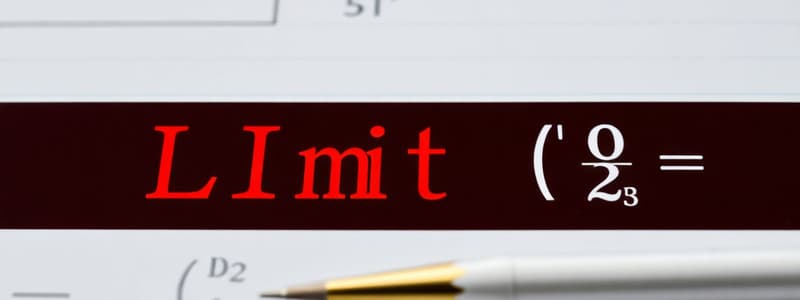Podcast
Questions and Answers
State the Squeeze Theorem for functions defined around a point $a \in \mathbb{R}$.
State the Squeeze Theorem for functions defined around a point $a \in \mathbb{R}$.
If $g(x) \leq f(x) \leq h(x)$ for all $x$ in an open interval containing $a$ (except possibly at $a$) and $\lim_{x \to a} g(x) = \lim_{x \to a} h(x) = L$, then $\lim_{x \to a} f(x) = L$.
Evaluate $\lim_{x \to -4} \frac{(x + 4)^2}{x^2 - 16}$.
Evaluate $\lim_{x \to -4} \frac{(x + 4)^2}{x^2 - 16}$.
- 1/8
- $\infty$
- DNE
- 0 (correct)
Evaluate $\lim_{x \to \infty} \frac{\sqrt{x^6 + x + x^2}}{5x^3 + 4x^2}$.
Evaluate $\lim_{x \to \infty} \frac{\sqrt{x^6 + x + x^2}}{5x^3 + 4x^2}$.
- 0
- $\infty$
- DNE
- 1/5 (correct)
Evaluate $\lim_{x \to 1^+} \frac{e^{x-1}}{x - 1}$.
Evaluate $\lim_{x \to 1^+} \frac{e^{x-1}}{x - 1}$.
Let $k$ be a real number and $f(x) = \begin{cases} \frac{x^2 - 1}{x - 1} & \text{if } x \neq 1 \ k & \text{otherwise} \end{cases}$. For which value(s) of $k$, if any, is the function $f$ continuous?
Let $k$ be a real number and $f(x) = \begin{cases} \frac{x^2 - 1}{x - 1} & \text{if } x \neq 1 \ k & \text{otherwise} \end{cases}$. For which value(s) of $k$, if any, is the function $f$ continuous?
Let $g(x) = (x + 2)^2$. Use the formal definition of the derivative to find $g'(x)$.
Let $g(x) = (x + 2)^2$. Use the formal definition of the derivative to find $g'(x)$.
Find $h'(x)$ when $h(x) = \cos((x + 7)^2)$.
Find $h'(x)$ when $h(x) = \cos((x + 7)^2)$.
Find $j'(x)$ when $j(x) = x^2 \sin(x)$.
Find $j'(x)$ when $j(x) = x^2 \sin(x)$.
Find an equation of the tangent line to $y = \sin^2(x)$ at the point $(\frac{\pi}{2}, 1)$.
Find an equation of the tangent line to $y = \sin^2(x)$ at the point $(\frac{\pi}{2}, 1)$.
Let $k$ be a real number and let $f(x) = \begin{cases} \frac{\ln(1 - k^2x)}{2x^2 - 4x} & \text{if } x < 0 \ k & \text{if } x \geq 0 \end{cases}$. For which values of $k$, if any, is the function $f$ differentiable?
Let $k$ be a real number and let $f(x) = \begin{cases} \frac{\ln(1 - k^2x)}{2x^2 - 4x} & \text{if } x < 0 \ k & \text{if } x \geq 0 \end{cases}$. For which values of $k$, if any, is the function $f$ differentiable?
Perform row operations to reduce the matrix $\begin{bmatrix} 1 & 2 & -1 & 2 \ 1 & 2 & -1 & 4 \ 2 & 4 & -2 & 5 \end{bmatrix}$ to reduced row echelon form. Indicate which row operations you use.
Perform row operations to reduce the matrix $\begin{bmatrix} 1 & 2 & -1 & 2 \ 1 & 2 & -1 & 4 \ 2 & 4 & -2 & 5 \end{bmatrix}$ to reduced row echelon form. Indicate which row operations you use.
Study the following linear systems, represented by their augmented matrices in echelon form. Which of these systems has a single unique solution?
Study the following linear systems, represented by their augmented matrices in echelon form. Which of these systems has a single unique solution?
The system represented by the augmented matrix $\begin{bmatrix} 1 & 1 & b \ 0 & k & b \end{bmatrix}$ has infinitely many solutions only when $k = 0$ and $b = 0$.
The system represented by the augmented matrix $\begin{bmatrix} 1 & 1 & b \ 0 & k & b \end{bmatrix}$ has infinitely many solutions only when $k = 0$ and $b = 0$.
Write out the general solution to the linear system in vector parametric form, given the augmented matrix in reduced row echelon form: $\begin{bmatrix} 1 & 1 & 1 & -2 & 0 & -3 \ 0 & 0 & 0 & 1 & 2 \ 0 & 0 & 0 & 0 & 0 & 0 \end{bmatrix}$.
Write out the general solution to the linear system in vector parametric form, given the augmented matrix in reduced row echelon form: $\begin{bmatrix} 1 & 1 & 1 & -2 & 0 & -3 \ 0 & 0 & 0 & 1 & 2 \ 0 & 0 & 0 & 0 & 0 & 0 \end{bmatrix}$.
For what value(s) of $k$ is the vector $\begin{bmatrix} -2 \ 2 \ k \end{bmatrix}$ in the span of the vectors $\begin{bmatrix} 1 \ 0 \ 1 \end{bmatrix}$ and $\begin{bmatrix} -1 \ 1 \ 2 \end{bmatrix}$?
For what value(s) of $k$ is the vector $\begin{bmatrix} -2 \ 2 \ k \end{bmatrix}$ in the span of the vectors $\begin{bmatrix} 1 \ 0 \ 1 \end{bmatrix}$ and $\begin{bmatrix} -1 \ 1 \ 2 \end{bmatrix}$?
Calculate the vector given by the matrix-vector product $\begin{bmatrix} 1 & 1 & 2 \ 1 & 1 & 0 \ -1 & 0 & 1 \end{bmatrix} \begin{bmatrix} 1 \ 0 \ 2 \end{bmatrix}$.
Calculate the vector given by the matrix-vector product $\begin{bmatrix} 1 & 1 & 2 \ 1 & 1 & 0 \ -1 & 0 & 1 \end{bmatrix} \begin{bmatrix} 1 \ 0 \ 2 \end{bmatrix}$.
Let $A$ be an $m \times n$ matrix, with its columns, in order, being the vectors $a_1, a_2, ..., a_n$ in $\mathbb{R}^m$. For a vector $x$ in $\mathbb{R}^n$, write down the definition of the matrix-vector product $Ax$.
Let $A$ be an $m \times n$ matrix, with its columns, in order, being the vectors $a_1, a_2, ..., a_n$ in $\mathbb{R}^m$. For a vector $x$ in $\mathbb{R}^n$, write down the definition of the matrix-vector product $Ax$.
The set ${\begin{bmatrix} 1 \ 0 \ 2 \end{bmatrix}, \begin{bmatrix} 1 \ 0 \ 2 \end{bmatrix}, \begin{bmatrix} 1 \ 1 \ 1 \end{bmatrix}}$ is linearly independent.
The set ${\begin{bmatrix} 1 \ 0 \ 2 \end{bmatrix}, \begin{bmatrix} 1 \ 0 \ 2 \end{bmatrix}, \begin{bmatrix} 1 \ 1 \ 1 \end{bmatrix}}$ is linearly independent.
Let $A$ be an $m \times n$ matrix (with $m$ rows and $n$ columns). Which of the following would guarantee that the columns of $A$ are linearly dependent?
Let $A$ be an $m \times n$ matrix (with $m$ rows and $n$ columns). Which of the following would guarantee that the columns of $A$ are linearly dependent?
To pass the hurdle requirement for the exam, a score of at least ______ out of 20 is required.
To pass the hurdle requirement for the exam, a score of at least ______ out of 20 is required.
Flashcards
Squeeze Theorem
Squeeze Theorem
The Squeeze Theorem states that if g(x) ≤ f(x) ≤ h(x) for all x in an interval containing a (except possibly at a), and lim x→a g(x) = lim x→a h(x) = L, then lim x→a f(x) = L.
Indeterminate Form 0/0
Indeterminate Form 0/0
The limit of a quotient where both numerator and denominator approach zero. Requires techniques like factoring or L'Hôpital's Rule.
Continuity of a Function
Continuity of a Function
A function f is continuous at a point c if f(c) is defined, lim x→c f(x) exists, and lim x→c f(x) = f(c).
Formal Definition of Derivative
Formal Definition of Derivative
Signup and view all the flashcards
Echelon Form Matrix
Echelon Form Matrix
Signup and view all the flashcards
Reduced Row Echelon Form
Reduced Row Echelon Form
Signup and view all the flashcards
Unique Solution Linear System
Unique Solution Linear System
Signup and view all the flashcards
Linearly Dependent Columns
Linearly Dependent Columns
Signup and view all the flashcards
More Columns Than Rows
More Columns Than Rows
Signup and view all the flashcards
Exam Score
Exam Score
Signup and view all the flashcards
Study Notes
- This is for the MATH1013 - Mathematics and Applications 1, Semester 1, 2025, Mastery Hurdle Exam 1 PART A ONLY, SAMPLE Exam 2
- The exam duration is 90 minutes
- The reading time is 0 minutes
- An English-to-foreign-language dictionary (clear of annotations) is permitted and optional for students who have English as a second language
- Calculators, electronic devices, books, and notes are not allowed, with the exception of paper dictionaries
- Provided to students is scribble paper.
- The exam includes 20 problems, and completing all problems is expected
- Each problem is worth 1 mark, and no partial credit is awarded
- A score of at least 16 out of 20 is required to pass the hurdle requirement
- A passing score earns 10% of your final grade
- Page 8 is blank, use this if you need extra work space
- A good strategy is to not spend too much time on any one problem; average time is 4.5 minutes per problem.
- When evaluating a limit, the correct answer is a number, ∞, −∞, or DNE
Questions
- C1: State the Squeeze Theorem for functions defined around a point 𝑎 ∈ R.
- C2: Evaluate lim (𝑥 + 4)2 / (𝑥→−4 𝑥 2 − 16)
- C3: Evaluate lim √𝑥6 + 𝑥 + 𝑥2 / (𝑥→∞ 5𝑥 3 + 4𝑥 2)
- C4: Evaluate lim 𝑒 𝑥−1 / (𝑥→1+ 𝑥 −1)
- C5: Determine the value(s) of 𝑘 for which the function 𝑓 is continuous: f(x) = x^2-1/x-1 if x!=1 and k otherwise.
- C6: Let 𝑔(𝑥) = (𝑥 + 2) 2. Use the formal definition of the derivative to find 𝑔′ (𝑥).
- C7: Find ℎ′ (𝑥) when ℎ(𝑥) = cos ((𝑥 + 7) 2)
- C8: Find 𝑗 ′ (𝑥) when 𝑗 (𝑥) = 𝑥 2 sin 𝑥.
- C9: Find an equation of the tangent line to 𝑦 = sin2 𝑥 at the point (𝜋/2, 1).
- C10: Determine value(s) of 𝑘 for which function 𝑓 is differentiable where f(x) = ln(1-k^2x) if x<0 and 2x^2-4x if x>=0.
- LA1: Perform row operations to reduce the provided matrix to reduced row echelon form.
- LA2: Determine the matrices in echelon form
- LA2: Determine the matrices in reduced row echelon form
- LA3: Determine which of the linear systems, represented by their augmented matrices in echelon form has a single unique solution from those provided
- LA4: Determine when the system has infinite solutions
- LA5: Write out the general solution to this system, in vector parametric form
- LA6: Find the value(s) of k for which the vector is in the span
- LA7: Calculate the vector given by the matrix-vector produce
- LA8: Give the definition of the matrix-vector product 𝐴x
- LA9: Determine if the set is linearly independent
- LA10: Determine what would guarantee that the columns of A are linearly dependent
Studying That Suits You
Use AI to generate personalized quizzes and flashcards to suit your learning preferences.



